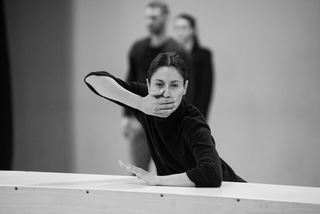by Susannah Clapp | 24 April 2022
★★★★★
theguardian.com
The immersive theatre trailblazers return with an all-consuming vision of the siege of Troy
Seventeen years ago, Punchdrunk began to change the way I felt. I remember my first encounter with the company in a misty factory near the Oval. And my transforming moment coming out of Faust in a five-storey Docklands warehouse a year later: the experience was so all-encompassing I had to shake myself into everyday life and architecture, eyes shrinking and expanding.
Felix Barrett, the artistic director, and the choreographer Maxine Doyle have also altered the theatre – in entirely unexpected ways. They don’t produce new words; their shows are mostly silent. They don’t directly suggest social or political change, or offer a new version of character. Yet their shows – in which the audience mingle with the action, spectators deciding what they see – involve an intense refocusing, a hesitation between being lost and taking control. Barrett and his co-director Doyle do not describe what they do as “immersive theatre”. Rightly: the term suggests a tour around an ancient kitchen where someone dressed up in a pinny and mobcap says hello to you over a saucepan. Punchdrunk alter the very texture of things: they provide microscopic, drilling detail, but at the same time they swivel an audience’s sense of space.
The company have not had a large show in London for nine years – though there have been performances in New York and Shanghai – and they have never had a permanent home in this country. Now they have settled in Woolwich, making 100,000 sq ft of two former ammunitions factories into performance spaces. These vast industrial buildings seem capable of conjuring a sense of infinite area. Where better to think about war, the waging of it and its devastating effects.
The current embracing of all things classical – the National has just announced that a large-scale adaptation of The Odyssey will take place across the country next year – involves a search for a vocabulary that can encompass arbitrary and predictable terrors: blows from the gods and cycles of revenge horror. The Burnt City, a vision of the siege of Troy, draws on Aeschylus’s Agamemnon and Euripides’s Hecuba. It is not so much a re-enactment as a response to these works.
The audience enters through the mock-up of an archaeological exhibition about Troy, which introduces the idea of sifting layers of evidence and significance. From then on, everyone’s experience will be slightly different. Speech is banned and spectators are obliged to wear bone-white masks covering foreheads and noses. Actors are the only ones with faces here; scenes are surrounded by a throng of identical blank, beaky stares. Audiences can try to piece together stories by following one actor, or drift around the space, soaking and accumulating. Their movement becomes part of the disturbing current of the evening. Some rummage through rooms turning over objects as if they were sanitary inspectors or spies; others push people aside to be close to their favourite character. Everyone is likely in turn to feel bewilderment, exasperation, quickening, wonder.
Two buildings hold the Greek and the Trojan experience. Neither is simply classical but inflected by references to Fritz Lang’s Metropolis and Weimar decadence, with costumes nodding to Alexander McQueen. In the Greek city of Mycenae, sand is underfoot in a cavernous space where huge wooden beams, balanced against each other like crosses, stand in swirling, smoky light. There is the roar of storm and melancholy calls from woodwind. Scenes are delivered sometimes as ritual, sometimes as dance fragments, body-bending fights, gymnastic mysteries. Sometimes you have to let go of clarity: I don’t mind that I don’t know who the character was who, making his hammock into a trapeze, twisted so dextrously that he seemed himself to be a piece of canvas.
The clearest storyline belongs to Iphigenia. Under a billowing canvas, the campaign headquarters of her father Agamemnon is reconstructed as a mix of classical references and an early 20th-century office: dial phones, manual typewriter, a painting of Clytemnestra above the desk and a letter warning of prophecies. Iphigenia’s bedroom – that of a young girl who thinks she is off to be married – is exquisitely constructed with a doll’s house and soft toys; a floral diary contains love lyrics copied out by hand, and a magazine snippet about June brides. She goes to meet her lover on one of those cruciform beams; she is sacrificed there by her father.
Driving narrative is not Punchdrunk’s strong suit. Actually, the more driving (as in their 2009 It Felt Like a Kiss) the less original. They are creators of distilled moments. Crossing a border checkpoint into Troy, reimagined as a hub of decadence, you can see the Hotel Elysium (“no refunds”), a room in a tenement building with a half-eaten supper congealing in a Baby Belling, and a woman writhing in all-over leather as she waits for her dealer; Willow Weep for Me is playing. Almost most impressive are the apparently redundant rooms, places that might have been left as sketches but are meticulously realised: a taproom that has kegs of “Styx” and “Hades”; a pottery shop with rows of tiny clay figures of Poseidon and Athena. The most static scenes can contain an inward energy: magnificently, they urge you to look for the past that has made them.
Read the review on theguardian.com
The Burnt City is booking until 24 September 2023



